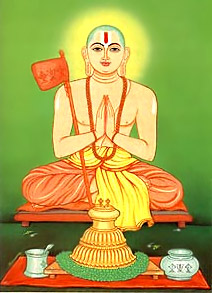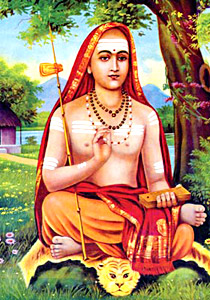 Philosophy in the Gupta age primarily reflected the notions of Vedic and post Vedic periods. The notable philosophers were Kumaril Bhatta, Shankar, Ramanuja, Madhava and Nimbarka. The beginning of the period also witnessed in which the lead was taken by Kumaril Bhatta and Shankar. As a result of a campaign between group of Hinduism and Buddhism, the latter almost disappeared from the land of its birth and neo-Hinduism was born.
Philosophy in the Gupta age primarily reflected the notions of Vedic and post Vedic periods. The notable philosophers were Kumaril Bhatta, Shankar, Ramanuja, Madhava and Nimbarka. The beginning of the period also witnessed in which the lead was taken by Kumaril Bhatta and Shankar. As a result of a campaign between group of Hinduism and Buddhism, the latter almost disappeared from the land of its birth and neo-Hinduism was born.
Among the neo-Hindu missionaries Kumaril Bhatta was the most renowned. He had a fierce and relentless campaign against the Buddhists. He believed in the Karma-Marga, that is, salvation by the sole means of the faithful performance of Karmas. Kumaril Bhatta revived the study and practice of Vedic rites and ceremonies simultaneously combating Buddhism by weapons taken from Vedic philosophy.
Shankara was the greatest philosopher of the age. He was of the Nambudiri class of Brahmans of Malabar. He had learnt all the Vedas and the Vedangas by the time he was eight years old. He travelled throughout India, combating Buddhism, founding monasteries and spreading the gospel of Vedantism. He founded his chief centre of learning at the source of the Tungabhadra River and it is famous as the `Sringeri Math,`
Shankara is the greatest philosopher produced by India in the medieval age. His philosophy acted as the cementing bond of neo-Hinduism. He merged all the contemporary Vedic faiths by means of a cardinal coordinating idea. Shankara in his philosophy of Vedantism started with the hypothesis of illusion or ignorance. Only the supreme spirit exists.  The chief means of attaining this is the cultivation of true knowledge that is the study of the Vedanta and the incessant contemplation of its teachings. Shankara emphasized the path of knowledge, the Jnana Marga and asceticism for attaining salvation. The weakness of Shankara was neglect of Bhakti or devotion as a means of salvation. Other notable philosophers are Ramanujacharya, Madhava and Nimbarka. The `alvars` of south had stressed the doctrine of Bhakti as a means to attainment of salvation and their doctrines were given philosophical expression by Ramanuja and other philosophers.
The chief means of attaining this is the cultivation of true knowledge that is the study of the Vedanta and the incessant contemplation of its teachings. Shankara emphasized the path of knowledge, the Jnana Marga and asceticism for attaining salvation. The weakness of Shankara was neglect of Bhakti or devotion as a means of salvation. Other notable philosophers are Ramanujacharya, Madhava and Nimbarka. The `alvars` of south had stressed the doctrine of Bhakti as a means to attainment of salvation and their doctrines were given philosophical expression by Ramanuja and other philosophers.
Ramanuja propagated his teachings which were the basis of the new Vaishnavism of India. He had also toured India and his chief centre of learning and devotion is Srirangam. His philosophy is called Visishtadwuita or qualified monism. It is so called as it inculcates the advaita or oneness of God with attributes. God alone exists, all else is seen as his manifestation. Ramanuja regards the world as real and permanent but subject to the control of one Brahman. He needed a personal God to whom he could turn in troubles and difficulties. For this Ramanuja combined the old religious views of the Bhagvata with the Vedantic ideas of Shankara and emphasized the religious value of devotion and service and self-surrender to God. Bhakti was the most suitable means to achieve purity, sinlessness and selflessness in life and was the truest means for the attainment of salvation or Moksha. Ramanuja was the founder of the modern Sri-Vaishnava sect.
Madhava was another great apostle of Vaishnavism was gave us the philosophy of dualism. His Vaishnavism is known as sad Vaishnavism and in his Dvaita philosophy he repudiates both the monism of Shankara and the modified monism of Ramanuja. According to him phenomenal world is real and eternal. The supreme spirit is Lord Vishnu and his consort Goddess Lakshmi. Madhava assigns a special place to Guru through whose intervention salvation is possible. The sect of Madhava is also distinguished by its various festivities all the year round.
In the north of India the first great philosopher of the Vaishnava school was Nimbarka during this period. His Vedantic theory is known as Dwaitadwaitavada or both monism and pluralism or dualism. He tried to reconcile both dualism and monism. His doctrines give predominance to self-surrender to God as the mode of salvation. He gives prominence to Lord Krishna and his mistress Radha.
The main philosophies of the medieval India tried to interpret Vedic and post-Vedic philosophical works. Their greatest emphases were not on knowledge or Karma action but on love and self-surrender to God. They deviated from true spirituality. These philosophies laid greater emphasis on the emotional aspects of man.



















